The AMD Radeon VII Review: An Unexpected Shot At The High-End
by Nate Oh on February 7, 2019 9:00 AM ESTCompute Performance
Shifting gears, we'll look at the compute aspects of the Radeon VII. Though it is fundamentally similar to first generation Vega, there has been an emphasis on improved compute for Vega 20, and we may see it here.
Beginning with CompuBench 2.0, the latest iteration of Kishonti's GPU compute benchmark suite offers a wide array of different practical compute workloads, and we’ve decided to focus on level set segmentation, optical flow modeling, and N-Body physics simulations.
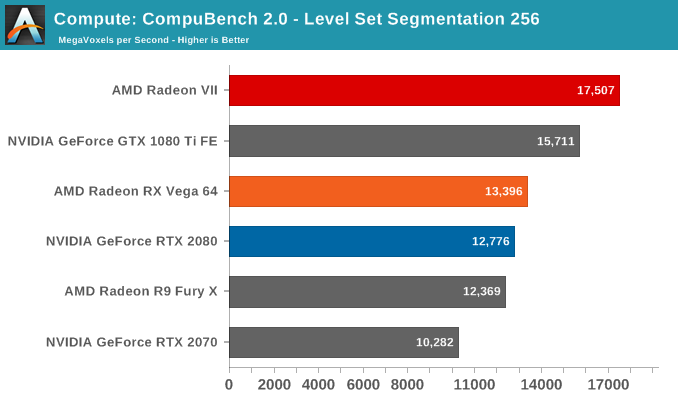
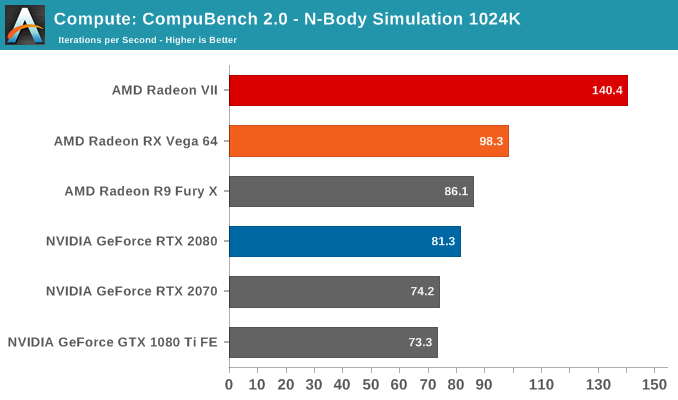
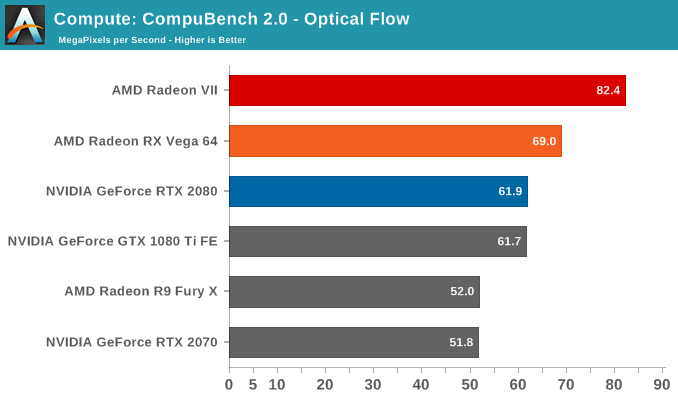
Moving on, we'll also look at single precision floating point performance with FAHBench, the official Folding @ Home benchmark. Folding @ Home is the popular Stanford-backed research and distributed computing initiative that has work distributed to millions of volunteer computers over the internet, each of which is responsible for a tiny slice of a protein folding simulation. FAHBench can test both single precision and double precision floating point performance, with single precision being the most useful metric for most consumer cards due to their low double precision performance.
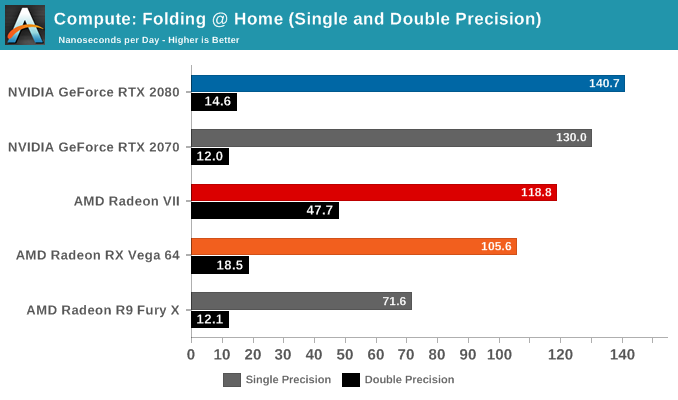
Next is Geekbench 4's GPU compute suite. A multi-faceted test suite, Geekbench 4 runs seven different GPU sub-tests, ranging from face detection to FFTs, and then averages out their scores via their geometric mean. As a result Geekbench 4 isn't testing any one workload, but rather is an average of many different basic workloads.
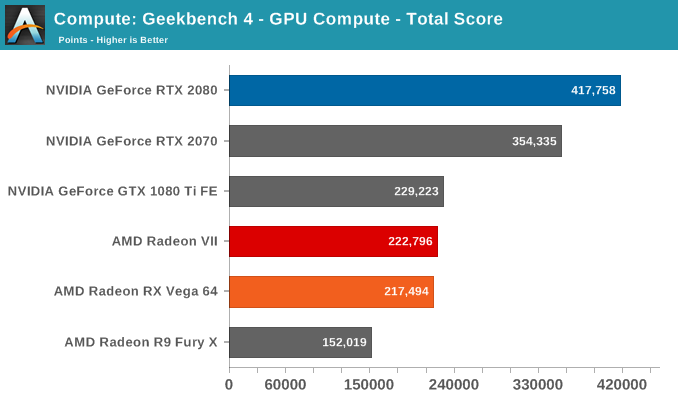
Lastly, we have SiSoftware Sandra, with general compute benchmarks at different precisions.
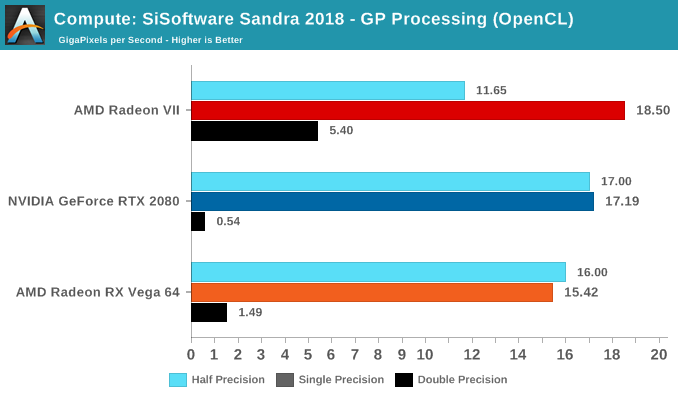
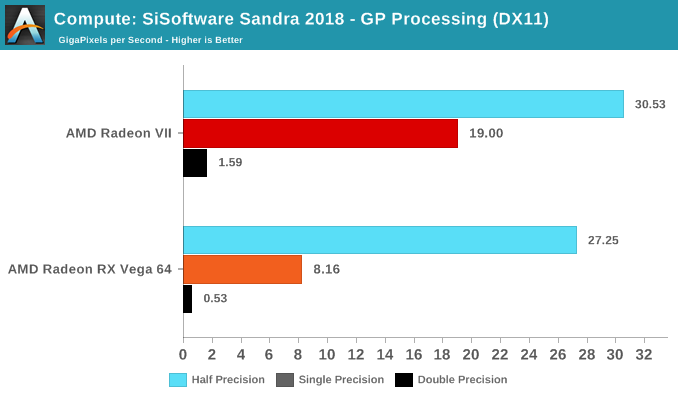
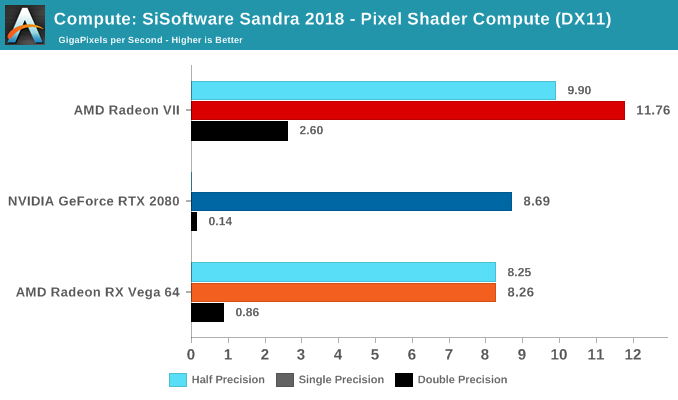










289 Comments
View All Comments
repoman27 - Thursday, February 7, 2019 - link
The Radeon Pro WX 7100 is Polaris 10, which does not do DSC. DSC requires fixed function encoding blocks that are not present in any of the Polaris or Vega variants. They do support DisplayPort 1.3 / 1.4 and HBR3, but DSC is an optional feature of the DP spec. AFAIK, the only GPUs currently shipping that have DSC support are NVIDIA's Turing chips.The CPU in the iMac Pro is a normal, socketed Xeon W, and you can max the RAM out at 512 GB using LRDIMMs if you're willing to crack the sucker open and shell out the cash. So making those things user accessible would be the only benefit to a modular Mac Pro. CPU upgrades are highly unlikely for that platform though, and I doubt Apple will even provide two DIMM slots per channel in the new Mac Pro. However, if they have to go LGA3647 to get an XCC based Xeon W, then they'd go with six slots to populate all of the memory channels. And the back of a display that is also 440 square inches of aluminum radiator is not necessarily a bad place to be, thermally. Nothing is open about Thunderbolt yet, by the way, but of course Apple could still add existing Intel TB3 controllers to an AMD design if they wanted to.
So yeah, in order to have a product, they need to beat the iMac Pro in some meaningful way. And simply offering user accessible RAM and PCIe slots in a box that's separate from the display isn't really that, in the eyes of Apple at least. Especially since PCIe slots are far from guaranteed, if not unlikely.
halcyon - Friday, February 8, 2019 - link
Apple cannot ship Mac Pro with a vacuum cleaner. That 43 dBA is isane. Even if Apple downclocked and undervolted the bios, I doubt they could make it very quiet.Also, I doubt AMD is willing to sell the tons of them at a loss.
dark_light - Thursday, February 7, 2019 - link
Well written, balanced and comprehensive review that covers all the bases with just the rightamount of detail.
Thanks Nate Oh.
Anandtech is still arguably the best site for this content. Kudos guys.
drgigolo - Thursday, February 7, 2019 - link
So I got a 1080Ti at launch, because there was no other alternative at 4K. Finally we have an answer from AMD, unfortunately it's no faster than my almost 2 year old GPU, priced the same no less.I really think this would've benefitted from 128 rops, or 96.
If they had priced this at 500 dollars, it would've been a much better bargain.
I can't think of anyone who I would recommend this to.
sing_electric - Thursday, February 7, 2019 - link
To be fair, you could almost say the same thing about the 2080, "I got a 1080 Ti at launch and 2 years later, Nvidia released a GPU that barely performs better if you don't care about gimmicks like ray tracing."People who do gaming and compute might be very well tempted, people who don't like Nvidia (or just do like AMD) might be tempted.
Unfortunately, the cost of the RAM in this thing alone is probably nearly $350, so there's no way AMD could sell this thing for $500 (but it wouldn't surprise me if we see it selling a little under MSRP if there is plentiful supply and Nvidia can crank out enough 2080s).
eva02langley - Thursday, February 7, 2019 - link
That was the whole point of RTX. Beside the 2080 TI, there was nothing new. You were having the same performances for around the same price than the last generation. There was no price disruption.Oxford Guy - Thursday, February 7, 2019 - link
Poor AMD.We're supposed to buy a clearly inferior product (look at that noise) just so they can sell leftover and defective Instincts?
We're supposed to buy an inferior product because AMD's bad business moves have resulted in Nvidia being able to devalue the GPU market with Turing?
Nope. We're supposed to either buy the best product for the money or sit out and wait for something better. Personally, I would jump for joy if everyone would put their money into a crowdfunded company, with management that refuses to become eaten alive by a megacorp, to take on Nvidia and AMD in the pure gaming space. There was once space for three players and there is space today. I am not holding my breath for Intel to do anything particularly valuable.
Wouldn't it be nice to have a return to pure no-nonsense gaming designs, instead of this "you can buy our defective parts for high prices and feel like you're giving to charity" and "you can buy our white elephant feature well before its time has come and pay through the nose for it" situation.
Capitalism has had a bad showing for some time now in the tech space. Monopolies and duopolies reign supreme.
eva02langley - Friday, February 8, 2019 - link
Honestly, beside a RX570/580, no GPUs make sense right now.Funny that Polaris is still the best bang for the $ still today.
drgigolo - Saturday, February 9, 2019 - link
Well, at least you can buy a 2080Ti, eventhough the 2080 is of course at the same price point as the 1080Ti. But I won't buy a 2080Ti either, it's too expensive and the performance increase is too small.The last decent AMD card I had, was the R9 290X. Had that for a few years until the 1080 came out, and then, replaced that to a 1080Ti when I got a Acer Predator XB321HK.
I will wait until something better comes along. Would really like HDMI 2.1 output, so that I can use VRR on the upcoming LG OLED C9.
sing_electric - Thursday, February 7, 2019 - link
Oh, also, FWIW: The other way of looking at it is "damn, that 1080 Ti was a good buy. Here I am 2 years later and there's very little reason for me to upgrade."